Archive for the composite Category
MyBauer Custom Player & Goalie Sticks Available Now!
Following up on the MyBauer custom skates, MyBauer custom sticks will be available in April 2019. What this means is you can order your very own Bauer custom sticks the same way the Pros do! Two options will be available
Custom– Starting with an existing stick, currently Vapor 1X Lite, Supreme 2S Pro, or Nexus 2N Pro you can then choose your-
Flex
Grip
Pattern (all Bauer retail patterns plus some max height options)
Color (9 to choose from)
Personalization (top of stick)
1 Stick Minimum

Pro Custom– This is where you can design a stick EXACTLY as you’d like it. Choose your-
Flex (including flexes not available at retail)
Kick Point (low, medium, high)
Shaft Shape (round, hybrid, square)
Grip
Blade Core (soft, medium, stiff)
Pattern (all retail patterns plus 5 unique pro patterns)
Color (9 to choose from)
Personalization (top and bottom of stick)
2 stick Minimum

Custom Goalie– Supreme 2S Pro or Vapor 2X Pro
Choose your-
Paddle Height
Shoulder Shape
Blade Pattern
Color
1 Stick Minimum

Come see one of our stick specialists and they’ll walk you through the quick and easy process and in about 4 weeks you’ll have Your Bauer Stick…Built By You!
2019 Staff Stick Recommendations For Tourney Time
There is no more important time of year for a hockey player than tournament time! Tournament time is the culmination of the season. It also tends to be the time of the year when your stick has seen better days after numerous slappers, blocks and slashes. Fear not, this is a great time to consider a new stick and we have a few recommendations to narrow down the choices.
Bauer Nexus 2N Pro– This premium, pro level stick is the latest version of the Bauer Nexus line. Nexus stands out as the first of the “Hybrid Flex” sticks featuring a mid-kick point and Sweet Spot Technology for a natural flex. This is Bauer’s most versatile, elite stick.

Warrior QX Pro– A staff favorite for overall performance-to-value in a pro stick. This is the same stick used by junior hockey and college hockey teams. They are exceptionally lightweight and durable, and are offered in an extra tall. The QX line offers a “natural flex” coupled with the Saber Taper and Minimus Carbon 800 for a versatile, high performance experience. Compare this stick to sticks that cost $80-$100 more and you’ll have a new favorite too!

Warrior QRE Pro– Another staff favorite for overall performance-to-value in a pro stick. This is the same stick used by junior hockey and college hockey teams. They are exceptionally lightweight and durable, and are offered in an “extra tall.” The QR line offers a low kick point, the most popular kick point in hockey, coupled with the unique Edge Taper and Minimus Carbon 1000 for a high performance, quick release stick. Compare this stick to sticks that cost $80-$100 more and you’ll have a new favorite too!

CCM SuperTacks AS1– The new SuperTacks AS1 pushes the boundaries of performance and will become the new standard for Mid-Kick point sticks. The stiffness profile has been revisited to maximize loading while providing great stability and control. Not only can players benefit from a great, powerful stick, the feel has been substantially improved. The new X-Flow technology allows for a 10g weight reduction while improving compaction for better durability.

CCM Tacks 9080– Another stick that rates highly in the performance-to-value ratio. Featuring the same mid-kick, maximum loading taper and intermediate geometry as the AS1 in a more affordable stick. At nearly 1/2 the price of an elite stick, this is one of the best deals around.


Introducing Raven Hockey Sticks For Young Players
We’re pleased to announce our new partnership with Raven Sticks, the first hockey sticks designed specifically for young players (under 100 lbs). The Raven philosophy is simple- All Hockey Players should be using a stick with a Flex Rating that equals less than 50% of your their body weight!
With this in mind they developed a simplified, color coded line of sticks that will give your young player the proper flex from the onset. As your player grows you simply move up to the next flex. Choosing the proper flex will allow your player to learn to shoot properly & LET IT FLY!
Which Raven Stick Should You Choose? Check Out This Flex Calculator
Raven Hockey Flex Calculator
For a limited time get the Raven sticks in Limited Edition Ninja graphics!
Staff Stick Recommendations For Tourney Time!
There is no more important time of year for a hockey player then tournament time! Tournament time is the culmination of the season. It also tends to be the time of the year when your stick has seen better days after numerous slappers, blocks and slashes. Fear not, this is a great time to consider a new stick and we have a few recommendations to narrow down the choices.
Bauer Supreme 1S– This premium, pro level stick is the latest version of the Bauer Supreme line. Like all Supreme sticks it features a higher kick point and shorter taper which Bauer calls the MPK (Maximum Power Kick). This, along with the new Renew Core Technology in the blade (for a longer lasting blade) make this an ideal stick choice
Warrior QX Pro– A staff favorite for overall performance-to-value in a pro stick. This is the same stick used by junior hockey and college hockey teams. They are exceptionally lightweight and durable, and are offered in an extra tall. The QX line offers a “natural flex” coupled with the Dagger Taper and Minimus Carbon for a versatile, high performance experience. Compare this stick to sticks that cost $80-$100 more and you’ll have a new favorite too!
True T-Pro– True has been making composite hockey sticks for other hockey companies for years. As one of the leading manufacturers of graphite/composite golf clubs in the world, they pack decades of experience into their hockey sticks. The T-Pro is the exact same stick that True makes for college and junior teams so they pack a ton of performance into a very reasonably priced package.
Bauer Vapor X-Shift– This exclusive model offers a ton of performance for under $200. Featuring a carbon constructed shaft- no fiberglas as in similarly priced models- and an upgraded 12K carbon blade, this stick is a nasty piece of work for sure!
The New STX Surgeon RX2 Hockey Sticks- Setting Out To Reshape The Game
In the modern era of composite hockey sticks there have been many innovations and changes. The one thing that has remained constant is the shape. For the most part the shape of sticks has been square or, more specifically, rectangular. STX is looking to change all that with the introduction of the Surgeon RX 2 composite stick line featuring Puregrip Technology.
Puregrip Technology gives you an entirely new way to take control of the game. Its innovative, ergonomic design on the underside of the shaft fills the void in your hand left by a traditional shaped hockey stick. The angular shape on the bottom of the stick maximizes hand contact points for advanced stick control and quick, responsive play.
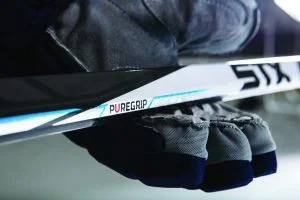
The Puregrip Technology Profile Maximizes Glove Feel
It has the familiar square top, but the bottom is like nothing you’ve ever played with before. It’s like the ultimate hybrid of a hockey stick and a lacrosse stick (STX being one of the leaders in LAX gear being completely coincidental). It has a great feel in the bare hand, but you really need to hold it with hockey gloves to fully appreciate just how different and comfortable this shape is. This unique ergonomic shape creates more contact points in the hand creating greater control.
The STX Surgeon RX2 sticks will be available on June 10th. Stop in and check out the shape of things to come!
Choose your weapon part 3; How and why composite sticks conquered hockey
Wow, hockey season really caught up on me and I’ve been derelict in my blogging duties. So, I present to you the third and final, highly anticipated (ok, it’s actually gone on at least 2 blogs too many) part of our discussion on composite hockey sticks (and as there have been no real comments it’s more a lecture then a conversation). We’ve covered the origins, the present, and the most important features in selecting a stick so let’s finish it off with popular misconceptions and rumors and, in the end, are they really worth the money.
1) Composite sticks last longer then wood sticks- Negative. A composite stick MAY last longer then a wood stick but can break just as quickly. The bottom line is hockey is a rough sport and sticks are going to break. In fact, they HAVE to break for safety reasons alone. The thought of an unbreakable stick (from a business standpoint it will happen right around the time of the 100 miles to the gallon engine) is scary in the amount of damage it could cause to the skater or an opponent could be significant.
2) More expensive composite sticks last longer then cheaper composite sticks- Wrong. My experience is most of the new, lower priced, lower performance sticks last quite a bit longer then the premium sticks. This is because they have a higher fiberglass content. On the other hand they play like a fiberglass stick…and that’s not a compliment.
3) You will get off a much better shot with a composite stick-Yes and no. It will always be the shooter not the stick. But, on a slapper or one-timer, the same player will typically see increased velocity with a high performance composite stick. That and lighter weight and better consistency is what you buy a composite stick for. Period. As far as passing and wristers many feel wood still works better but most importantly no matter what the material those 2 skills are more affected by the proper lie, flex and curve.
4) The price on premium composite sticks is going to come down- I don’t see it. The relatively high price of the RBK O Stick is proof of this. The bottom line is most manufacturers have moved stick production overseas to keep the cost from increasing more. Realistically, a lot of $100 and down sticks you now see use the technology that the $150 and up sticks used less then 5 years ago so you can get a decent stick at a decent price now. No, there is only one way the price of the premium sticks is coming down…get rid of the warranty. Yes, yes, I know, without that safety blanket people will be rioting in the streets but hear me out. The warranty was the most ill conceived notion ever. When the original composite sticks came out they needed the warranty to sell the sticks as the average wood stick was about $22. Ever since then the companies have been forced to roll the cost of the warranty into the price of the sticks. Company’s like Easton spend well over $1,000,000 a year in return postage alone and if you don’t think that cost, plus the cost of the replacement itself and the issues with falsified receipts (note the new authentication system on the new Easton Synergy Elite) have all driven the cost upwards. My idea? Offer a non-warranty stick for 1/3 to 1/2 less and let people take their chances. But, hey, what do I know
5) You can “save” a composite 1-piece stick by cutting the broken blade off and “repairing it”- Totally bad idea. If you want to try and get more out if it, flip it over and put a $20 or less wood blade in it and use it as a back up or pond stick. Simply put once it’s broken, it’s broken and to invest any money back in it is foolhardy. These are precision tools and altering them in any way changes everything about them. I know it’s a bitter pill to swallow but it’s the cold, hard, truth
So, in conclusion, are premium composite sticks worth their price? Hard to say. I think for the reduced weight, consistency, and added velocity on certain shots they are worth every penny for a high level player. If you are buying one for durability, they are NOT worth it. They are quite simply the next evolution in the hockey stick much in the way composite tennis racquet’s and golf shafts and heads have changed those sports. When people ask me I tell the, between $150-$200 for a competitive player, $100-$150 for recreational and wood below that (yes there are adult composite sticks for $60-$70 but in my opinion wood plays much better). The bottom line of the whole thing is a good stick will give a good player a competitive advantage but not necessarily a better player so worry more about your shooting skills and less about the trendiest new stick
Choose your weapon part 2; How and why composite sticks conquered hockey
So, where was I? Wood sticks…aluminum shaft…Z-Bubble…OK, got it. So we reviewed where composite sticks came from now let’s talk about why they work, what’s important in selecting a composite stick that is right for you
Probably the most common question I get asked about composite sticks is what’s the most important feature when selecting a stick. When I first started in this business and wood sticks were the norm I’d tell you the order of features ranked by importance was lie, curve, flex. For composite, while I’d actually list lie as #2, it tends to go flex, curve, lie, well, in reality for most younger players it goes curve, curve, curve but I digress. Texture and weight are 2 other elements to consider but far less important in the overall scheme of things. Let’s talk about flex, lie, and curve.
Selecting the proper flex of a composite stick is probably most important. The design of the original Easton Synergy was developed with the the physics of the swing of a golf club in mind. What this meant was that the bottom of the stick should flex enough that at the top of the swing the head, or in this case the blade, should flex back well behind the shaft and your hands. When the direction is reversed and the blade catches up to the shaft the result is catapult like creating a low, hard shot. So, basically stated, a stick that is too stiff will eliminate this explosiveness. Yes, on the other hand a stick too “whippy” loses some accuracy but your really buying a composite stick for the velocity benefit so much better to err on the side of too flexible. Most sticks are rated on the original Easton scale of 85, 100, 110 flex. At it’s basest explanation, think of it as pounds per square inch. An 85 flex would take approximately 85 pounds of pressure to bend one inch etc. For our purposes the scale is simply a standard measure with 85 being more flexible then 100 etc. So, now that you’ve decided on the flex there is one more curve ball; cutting the stick to height. Every 2 inches you cut a stick will increase the relative stiffness of the stick. It is MOST important to keep this in mind before your final decision is made. Decide and what would be your ideal flex then choose the stick that, when cut to you ideal height, achieves that flex. It’s not as confusing as it may sound but as always you can consult with your local hockey shop pro.
The lie of the blade and by extension the stick itself is every important. It is literally how the blade “lies” on the ice. Simple, right? Well, back when blade heels were less rounded it was maybe the most singular element of importance in your stick. It affected your stance, the way the blade struck the puck, and whether or not you’d find pucks sneaking under your blade. As the heels and bottoms of the blades became more and more rockered the importance of lie became lost in the shuffle to the point until recent years the lie was not even printed on most composite sticks at all. Advice here? Grab a stick, figure where you would cut it, hold it like you would at that cut height, stand in a ready position and see how much “daylight” is under your blade then adjust accordingly. One problem is that typically, each curve pattern come in only one lie so you will have to weight that decision which leads us to…
Curve patterns. Quite literally this is the size and position of the curve on any given blade. position is usually named as heel, mid, or toe curve. Each position has it’s advantages and drawbacks. The curve size runs from diminutive to maximum legal size (about 3/4″) with each having it’s own set of pluses and minuses. So how do you choose? Well, typically in the States the slighter mid or heel curve reins supreme (Forsberg, Modano). My theory is that a “vanilla ice cream” curve involves a lot less risk at the high price of most stick and so they are most popular. Most pros tend towards a severe heel wedge which strikes the puck in a similar fashion to a sand wedge in golf and provides a hard accurate shot. However as there is little actual “curve” only a really skilled player can get a great wrister or pass with this kind of curve. Bottom line is simply go with what you’re comfortable with or the right balance between curve and lie (see above) that works for you.
OK, this has run on a bit but the gist of it is whether it’s a Synergy SE, RBK 9K, or Nike Bauer ONE90, whether the lightest or most durable, grip or no grip start by making sure the flex, lie, and curve are what’s right for you and the rest will fall into place.
When next we meet we’ll discuss popular myths and misconceptions and are composite sticks really worth the money. Until then may all your shots be on net!
Choose your weapon part 1; How and why composite sticks conquered hockey
Unless you playing days ended before the Great One skated his last lap around the ice then you know buying a hockey stick is no longer a simple process. With traditional wood sticks all but forgotten at the upper levels of the game we are officially in the composite stick age. With prices about to max out at around $250 for the highly anticipated RBK 9K sticks, not skates, have become the most expensive part of the game. So, how did we get here and what should you consider when purchasing a composite hockey stick? This week I’ll talk about the genesis and then we’ll talk about the good, the bad, and the ugly of purchasing a composite stick.
So, how did wood sticks end up becoming nearly extinct? Well, there are a few reasons including but not limited to the price of lumber. The average performance wood stick had jumped to over $20 and most closer to $30. Mostly it was an issue of consistency that led the revolution. The limitation of wood sticks at the highest level was you couldn’t control such variables as knots, dryness, and general quality of the raw ingredients from one stick to another. Another issue became players needing a stiffer flex often had to suffer through a stick that was heavier then desired. The first step towards composite was aluminum. If you played any time from the 80’s to mid 90’s you likely remember the aluminum shaft. This was great in that is was much lighter and consistent…well, unless it bent. Which they did. A lot. Trying to shoot straight with a bent stick is never a great idea. The n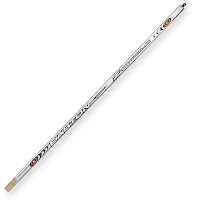 ext step was the composite shaft. The earliest versions were made through a process call pultrusion mostly used in the manufacture of boat masts. While this solved the problem of bowing and bending they had no play and were heavy. To me the stick that really changed the game was the Easton Z-Bubble shaft. The Z-Bubble incorporated a lot of golf club technology into the design figuring the swing of a club and a stick were pretty similar. What made this different was the taper at the bottom of the shaft. THIS was revolutionary. This created what was know as a focus flex region or, basically stated, an area of the stick that flexed back further and easier then the rest of the shaft keeping the head or blade behind the hands longer as well as explosive follow through. It was almost perfect except they had to deal within the boundaries of replacement blades with a square peg so they couldn’t mess with the geometry of the shaft itself too much (I know someone will mention the T-Flex shaft and blades which were really the true next step to the full composite stick but as it was generally considered a failure we’ll just skip over it). But change was just around the corner.
ext step was the composite shaft. The earliest versions were made through a process call pultrusion mostly used in the manufacture of boat masts. While this solved the problem of bowing and bending they had no play and were heavy. To me the stick that really changed the game was the Easton Z-Bubble shaft. The Z-Bubble incorporated a lot of golf club technology into the design figuring the swing of a club and a stick were pretty similar. What made this different was the taper at the bottom of the shaft. THIS was revolutionary. This created what was know as a focus flex region or, basically stated, an area of the stick that flexed back further and easier then the rest of the shaft keeping the head or blade behind the hands longer as well as explosive follow through. It was almost perfect except they had to deal within the boundaries of replacement blades with a square peg so they couldn’t mess with the geometry of the shaft itself too much (I know someone will mention the T-Flex shaft and blades which were really the true next step to the full composite stick but as it was generally considered a failure we’ll just skip over it). But change was just around the corner.
The full composite stick was the unicorn of the hockey world for several years. A lot of people will lay claim to the first full composite stick (my earliest recollection was a company called Busch which partnered up with everyone from Sherwood to Itech to get their product out there) but the hockey world simply wasn’t ready for a $200 stick. So, it was Easton, the leader in composite shafts and blades that finally broke through and quite by accident if you believe the stories. Stuck with the problem of showing around a prototype of a 1-piece composite stick that would retail at $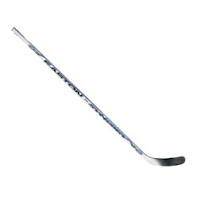 150, taking pre-orders, then not being able to produce the stick for a price that would make this price a reality. So, they went back to what was one of their biggest failures…yup, the T-Flex (see, you knew I mentioned it before for a reason). The end result was what has become known as a fused 1-piece stick. Basically taking a composite shaft with an ultra-long taper ending in an extremely narrow opening inserting a composite blade with a much shorter, much narrower peg and permanently bonding them together. Yes, this was the birth of the original Synergy. Now, to say it was an overnight success would be lying as sticker shock was still in affect. However, with improved looks, increased usage at the highest levels, and tremendous positive feedback, the revolution had truly begun.
150, taking pre-orders, then not being able to produce the stick for a price that would make this price a reality. So, they went back to what was one of their biggest failures…yup, the T-Flex (see, you knew I mentioned it before for a reason). The end result was what has become known as a fused 1-piece stick. Basically taking a composite shaft with an ultra-long taper ending in an extremely narrow opening inserting a composite blade with a much shorter, much narrower peg and permanently bonding them together. Yes, this was the birth of the original Synergy. Now, to say it was an overnight success would be lying as sticker shock was still in affect. However, with improved looks, increased usage at the highest levels, and tremendous positive feedback, the revolution had truly begun.
Today there are hundreds of composite sticks on the market claiming different manufacturing processes, lightest weight, most durable etc. Several companies have even perfected the “true 1-piece” stick (not fused). But, nearly a decade later, the “mistake” Easton made in it’s latest incarnation as the Synergy Elite remains the most popular and best known composite stick in hockey







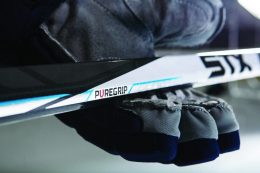

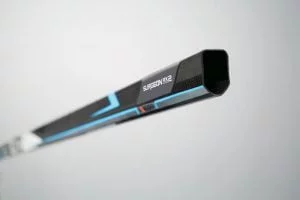







 Location:
Location:  Phone:
Phone:  Email: info@sportsetc.net
Email: info@sportsetc.net